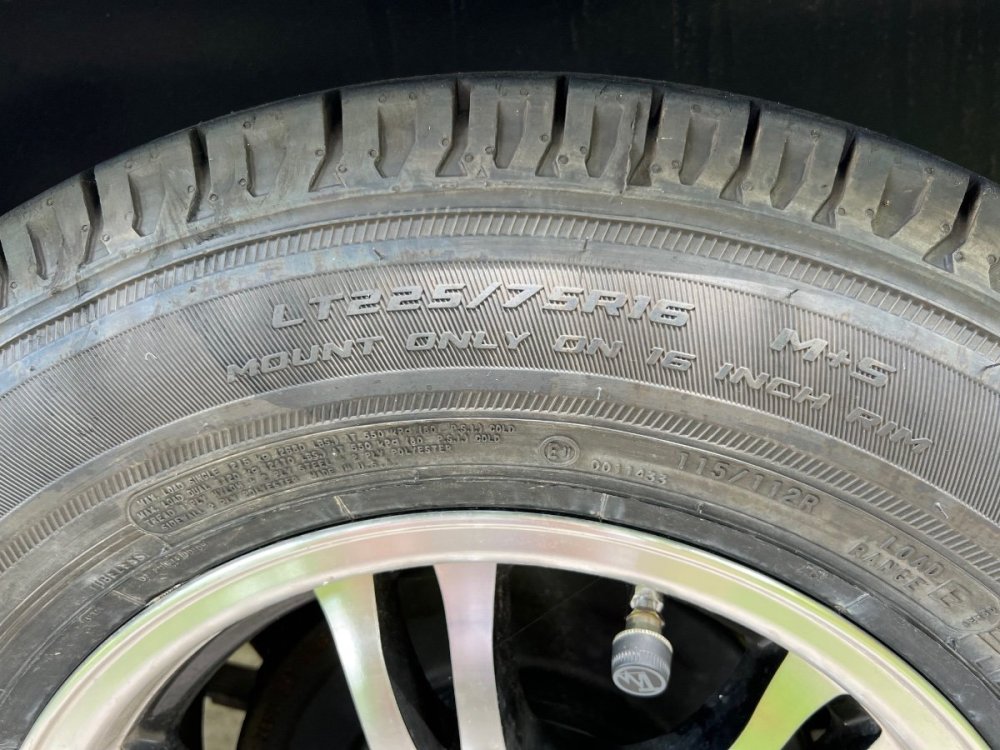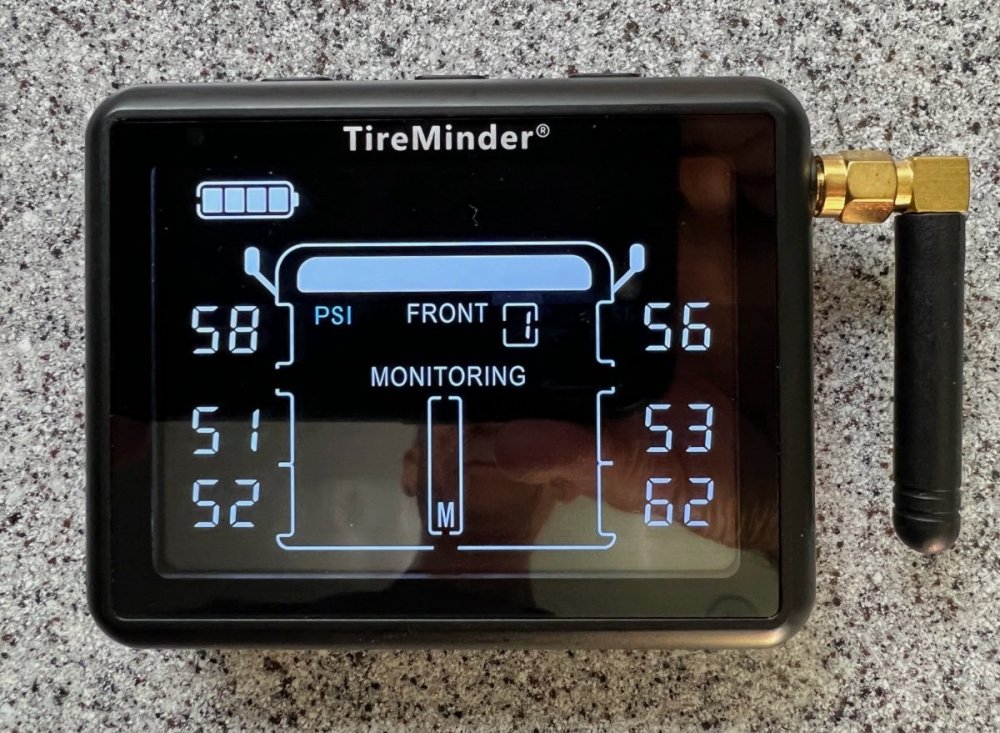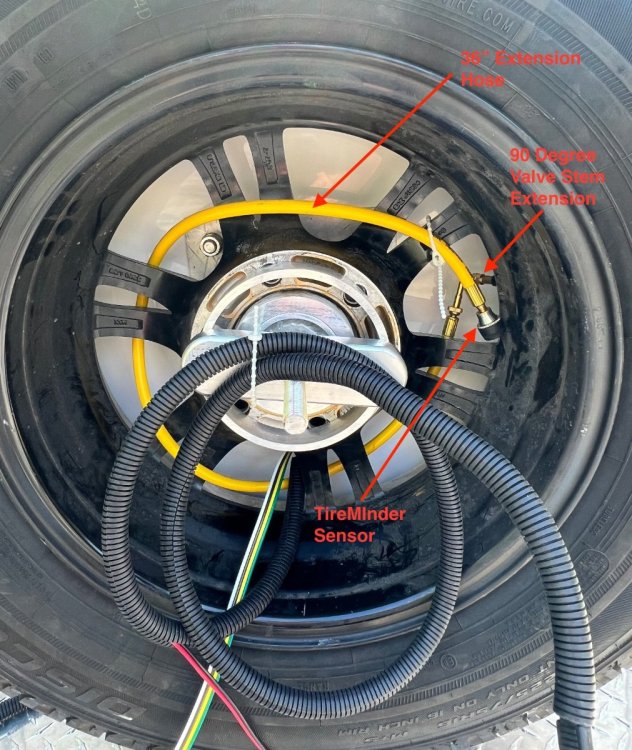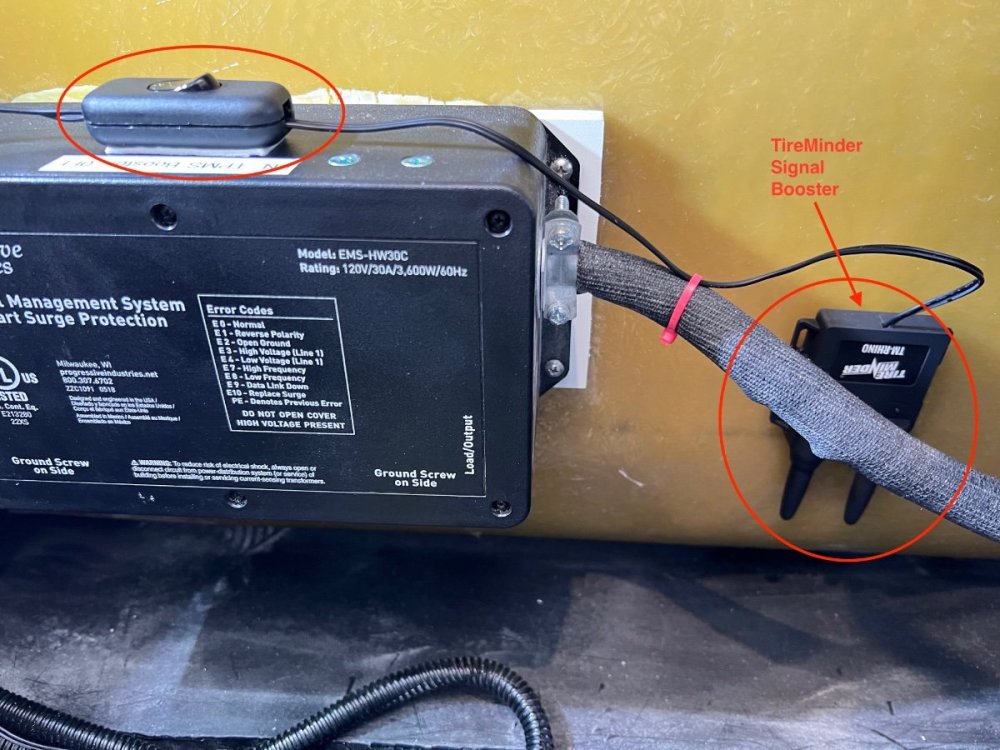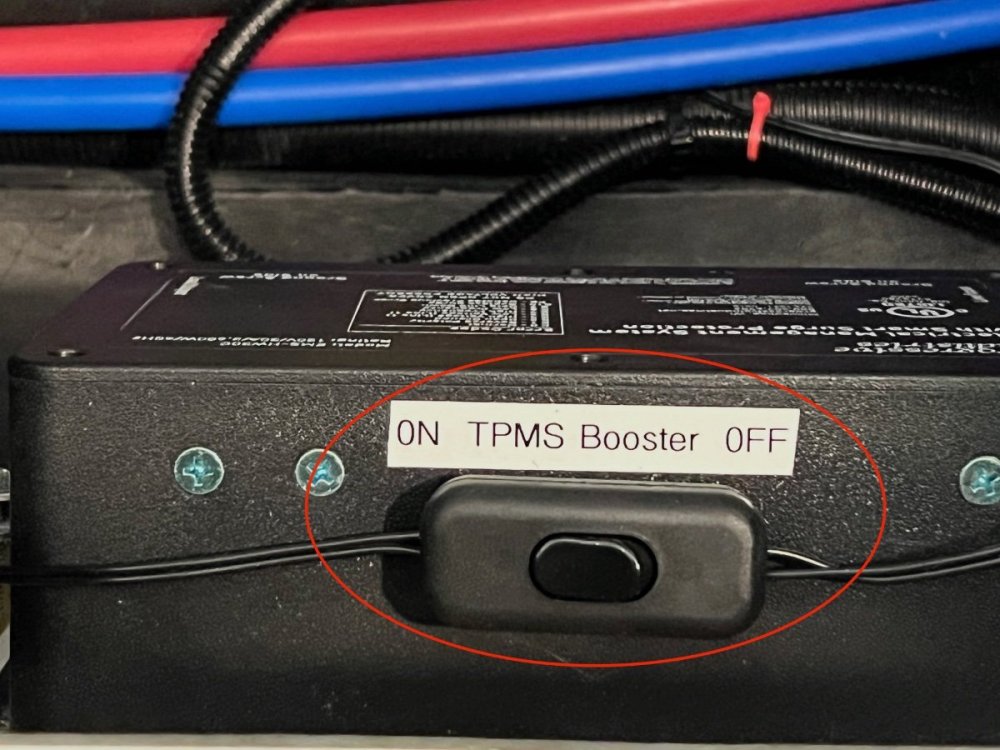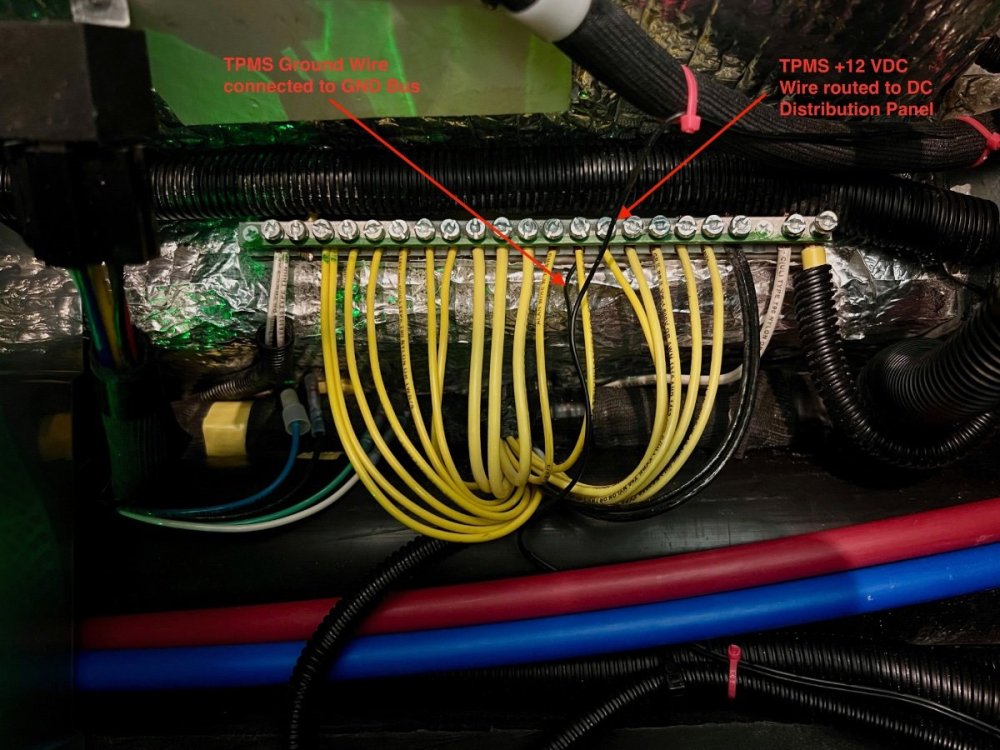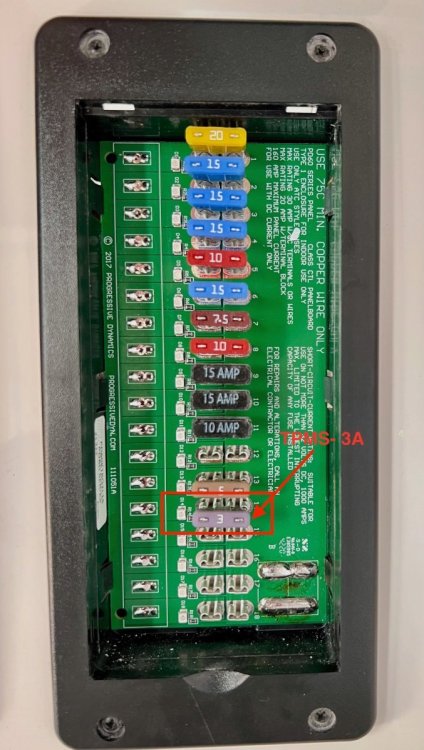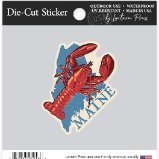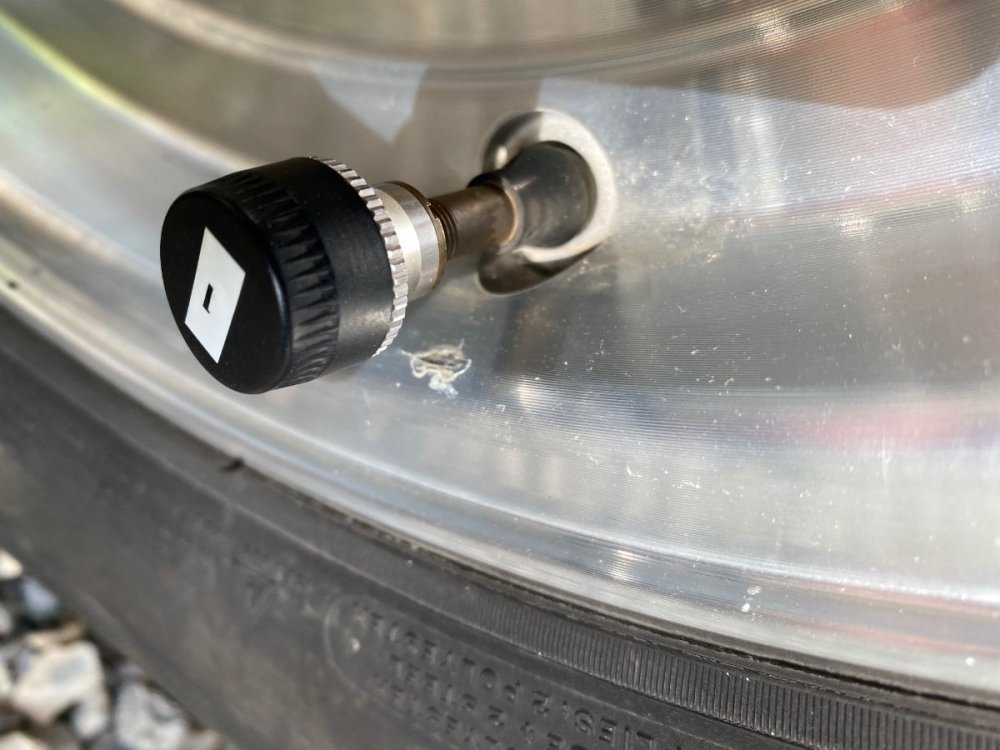Search the Community
Showing results for 'tpms'.
-
When I see stuff like that, my first question is how much pressure do you have in your tires? On an LE2, more than 50 psi will beat up your trailer and everything inside it. I run 42 psi (with a TPMS). I also removed my (fixed mount) tv the day after I got back from Tennessee 😬 That big crack might be repairable by removing the tv from the mount and epoxying a big aluminum plate there. John Davies Spokane WA
-
Our LEII, Hull 990, was delivered in mid-February, 2022. It is equipped with CooperLT225 /75R16 Cooper Discoverer HT3 tires: https://coopertire.com/en-us/find-tires/all-tires/discoverer-ht3 Treadwear up to 50,000 miles UTQG Load index/Speed Rating- 115\112R Load Range- E1 Tread Depth- 14.5mm At delivery the tires were inflated to 55psi and had rubber valve stems. Also, none of the wheels & tires were balanced at delivery. I recently took the trailer to a local Discount Tire location and had all five wheels/tires balanced and chrome steel valve stems installed on all wheels. The cost was just $112.06, with tax. Each wheel required a significant amount of weights to achieve dynamic balance. On several occasions, when checking tire pressure, the cores of the original rubber valve stems would stick open, allowing air to escape. On some of those occasions, I was able to use a pocket knife to probe the core and get it to reseat and close. The chrome steel valve stems provide a much more substantial mount for the TireMinder TPMS sensors on each wheel.
-
We recently had Oliver Service Center install a new Furrion Vision S Rear Camera on our Ollie. The original Voyager camera that it came with was diagnosed with water intrusion and was out of warranty. So a replacement was in order. The new Furrion S works great and we really appreciate long distance rear highway visibility and the safety factor when changing lanes when under way. A real plus is we can also see our bicycles when mounted up on our bike rack. The Furrion S also has a feature which allows the driver to hear the spotter when backing into a campsite as the camera has a microphone and the video monitor has a speaker. This allows the driver to see and hear voice commands of the spotter when backing up. Pretty cool tech if you choose to use it. The Mod- I decided to purchase an extra silicone dash mount for $13 which is the exact same mount we use for our “TST TPMS” system. The rubber mount holds the Furrion monitor securely on the dash which I prefer rather than use the suction cup on the w/s. The fit of the monitor into the silicone holder could not be more perfect. And now no more sticking a suction cup to the w/s for viewing the rear cam monitor. Just thought I would pass this along in case anyone is interested. A side note. I returned the Voyager Camera to the company that sells Voyager. They have agreed to replace the old camera which had water intrusion with a brand new one. They did not have to do this, as I was 6 months past the 1year warranty expiration. I have already promised/sold the Voyager to another Oliver owner with full disclosure of why I replaced it with a new Furrion. Pics of silicone mount, Furrion backup cam monitor and shark fin rear camera - TST silicone rubber dash mount - Rear Sharkfin camera- Furrion Vision S - Temporarily laid the mount on the dash to check line of sight visibility. I am still deciding on the best location for the monitor.
-
Shortly after arriving home from our delivery trip to Hohenwald, I installed a TireMinder i10 Tire Pressure Management System (TPMS), with six sensors, a monitor and a signal booster (installed later). Four of the sensors were fitted to the valve stems of the four trailer wheels on the ground, one on the trailer spare and one to the tow vehicle spare. The sensors transmit tire pressure and tire temperature status continuously to the small monitor in the tow vehicle. The 433 MHz RF signal booster is to ensure the signals from the sensors reach the monitor. The TPMS is quite configurable and can support up to 10 sensors simultaneously. Thresholds can be user specified and the system is preconfigured to create alerts for slow leaks or catastrophic loss of tire pressure. I first mounted the sensors to all the six wheels. The sensors appeared to have no problem communicating with the monitor in the tow vehicle. I deferred about a month installing the signal booster. Mounting the sensors is quite straightforward, requiring only insertion of provided disc batteries to the sensors, then screwing the sensors onto the valve stems. I like the inclusion of a lock nut to secure the sensors to the valve stems, using a provided small wrench. TireMinder Air Pressure & Temperature Sensor TireMinder i10 Monitor On each spare wheel I added 36" long extension hoses ($11 each) and 90 degree valve stem extensions ($7/pair), based on a recommendation from @John E Davies. The TireMinder sensors are mounted to the end of the extension hoses, which are routed through the wheel spokes to the accessible side of the spares. The valve stem extensions allow the hoses to be attached to the valve stems with no danger of kinking. These accessories eliminate a huge PITA- both spares are stored with their valve stems inaccessible. The trailer spare mounts with the valve stem facing the rear wall of the trailer. The tow vehicle spare is stowed valve stem down in a well under the cargo area at the rear of the vehicle. Now the TPMS reports the tire pressure with no hassle. Even if the spares require addition of air, the access is easy, without removing the spares from their storage positions. I always intended to install the signal booster, but had not settled on the best location. The installation instructions recommend locating the signal booster on the undercarriage, toward the front of travel trailers, with the antennas pointed toward the ground. The signal booster requires 12 volts DC for operation. I searched the OTTO forum seeking information on locations chosen by Oliver LEII owners for mounting such signal boosters. I found references to mounting signal boosters within the doghouse or in one of the upper storage compartments, neither of which appeared to offer ease of connection to a 12 VDC supply. Other owners indicated they had not installed the signal booster, since the monitor seemed to reliably provide tire pressure and temperature information. While vacuuming fiberglass dust from all areas accessible under the interior access hatches, I found what appeared to be an ideal location for the TPMS signal booster. The hatch under the rear dinette seat is the location of the Progressive Industries Surge Protector, mounted to the wall on the aisle side of the compartment. Adjacent to that location is a large area of unobstructed wall. Just below the surge protector is a ground bus and on the forward wall is the rear of the DC distribution panel. I believe this is a very desirable location for the signal booster. It is located low, slightly forward of the axles, in a protected space near the needed power supply. TPMS Signal Booster Location The TireMinder Signal Booster is attached to the fiberglass wall using an Industrial Velcro Coin, which enables easy removal. TPMS 12 VDC Power Switch I chose the top of the Progress Industries Surge Protector to mount a switch to turn the 12 VDC power supply to the TireMinder Signal Booster ON/OFF. The signal booster has a green light to indicate the power is ON. The wires from the signal booster are very thin and are both black (despite the instruction manual indicating one to be red and the other black). I don't believe it matters which is +12 VDC and which is Ground (GND). I routed the wires along cables in the compartment. The pink zip ties appearing in the photos provide clues to the routing. I arbitrarily selected a position on the Ground Bus to mount one of the wires to be Ground. The other wire was routed to the rear of the DC Distribution Panel, mounted on the forward wall of the compartment. Fuse position 14 was unused, so I selected it and connected the second wire from the TireMinder Signal Booster, using a crimp-on connector. Finally, I inserted a 3 amp fuse to the front side of the DC Distribution Panel, position 14. DC Ground Bus DC Distribution Panel (Rear) DC Distribution Panel (Front) Summary Although I had encountered no problems with the communication between the tire pressure/temperature sensors and the TireMinder Monitor, I believe having the signal booster installed reduces the risk of loss of communication between the sensors and the monitor. I have been leaving the signal booster on while traveling and turning power OFF when in storage. The signal booster draws only 75mA (Transmitting) to 14mA (Inactive). I tested the range with the signal booster installed and powered ON. I was able to walk over 300 feet from the trailer with the monitor receiving signals. I have been impressed with the TireMinder TPMS system. I have not mounted the monitor in the tow vehicle, but keep it on the center console, where I can view it as desired, and also hear any alarms which may occur. I purchased the TireMinder i10 and six sensors from TechnoRV (https://www.technorv.com/) for $279.65 (no shipping and no sales tax).
- 5 replies
-
- 10
-

-

-
Ours goes upside down on top of that fragile turntable spider thing, resting on an old towel that is folded up around the corners. A plastic Camco dish drainer and a box of Kleenex lie on that to keep it steady, though if the door ever opened of course it all would come out. Check your tire pressures, unless you just forgot to latch the door, something else is probably wrong! 42 to 45 psi for an LE2, NOT 50 60 or 80 especially for nasty pavement or gravel. For ugly low speed and really rough roads drop it by 10 pounds. (You definitely do need a TPMS when running lower AKA correct pressures. Last trip we had around 50 miles of straight flat (small) washboard gravel ranch roads, cruising speed when possible was 35 to 40 mph and nothing shook loose inside the Ollie. But you have to pack your gear so it can’t move around, especially in the overhead cabinets and in drawers, which should be strapped closed. When you get a chance, please try reposting pictures, the first one is lost in space. Enjoy your trip, get to Kennecott copper mine if you are into old ghost towns and equipment. White Horse is worth a couple of days. How are the fuel prices in BC and AK? (Woah, stupid Autocorrect changed fuel to girl!) John Davies Spokane WA
-
Definitely, get a tpms.
-
I agree with Sherry, don’t be intimidated! Relax, you’ll have a brand new trailer and you don’t need to worry about having a tool for every need. If you have an issue on the road there will be a Walmart or Home Depot nearby to get what you need. We had a basic set of tools when we picked up and didn’t need anything on our trip back to San Antonio. The only thing I would recommend is a TPMS that you can install after you pick up and are camping at the factory. Mike
-
I'm guessing that your 2017 Ford Expedition has a dashboard design that is very similar to my 2017 Ford F-150. If that is the case - I mounted my TPMS on the driver's side "A" pillar (top) and dash (bottom). The Garmin is mounted via the rack detailed below. My cell phone is in a cup holder mount and my tablet resides on the large arm rest that is between the seats. The radar detector is suspended from the headliner and the dashcam is behind the rearview mirror while the Garmin InReach Mini also resides just behind the rack that holds the Garmin GPS. All of this is without obstructing the view out of the windshield and/or the instruments on the dash or controls. Before I had the 890, my old 2797 (5x7 inch screen) was simply mounted on a "bean bag mount" and placed in that tray where I now have the rack.
-
Our TPMS lives in the center of the dash in the cubby there. The Garmin took up too much windshield real estate when mounted on the dash. This is a nice, clean solution that puts it below the windshield and within easy reach of our navigator. Mike
-
We leave our tpms monitor in the tray forward of the console. It kept falling off the velcro.
-
I am thinking of getting the Garmin RV 780 as it's smaller. I will have the TPMS also to put somewhere. It's going to be tricky to find places for both things that still allow me to see the road.
-
There are pros and cons to the Nev-R-Lube bearings. John Davies posted this concern on another thread: "FYI a replacement Nev-R-Lube bearing assembly itself is extraordinarily expensive and it may require a hydraulic press to install it. So in the event of a failure you will need a tow and a professional automotive or machine shop to fix it - unlike a regular bearing design that can be replaced by a skilled owner with hand tools. A tow will be covered by your roadside assistance insurance, but down time and mental anguish will be high and the shop will charge maybe $100 for labor. You can buy a mechanical puller and do it if you feel capable. Most owners would not be…. http://www.dexterpartsonline.com/files/2036913/uploaded/Nev-R-Lube Bearings.pdf If the failure is catastrophic, it will trash your brake and perhaps your axle. If you camp in the West in remote areas, the NevR Lube bearings are a huge liability. Some RV shops won’t work on them. They DO fail. If you get this kind of axle, buy and carry a spare bearing, because the parts are not commonly found everywhere. The only way I would want this setup is with disk brakes that have slip on rotors. That way you can carry a complete spare hub assembly and change it yourself in half an hour, and then get the failed bearing replaced at your leisure. Google “Nev-R-Lube bearing failure”. PS, don’t overload your axles. Do use a TPMS so you will get a heat warning in time. John Davies Spokane WA" Our 2022 Elite II will have Nev-R-Lube axles. I plan to follow John's advice and carry a couple of spare bearings, so even if I must have the trailer towed to a nearby shop for repairs if I have a failure on the road, I will have the necessary bearings in hand to expedite the repair process.
-
A friend with 2021 Ford f150 is ordering an Elite. Can anyone tell me if Ford supplied tpms and backup camera is available to work woth Ford screen?
-

Annual Maintenance & Tire Pressure Check & TPMS
mossemi replied to Steve-Gwenne's topic in Mechanical & Technical Tips
Although my TPMS sensors were marked at the time of the original installation, if I install them one at a time, the monitor shows the location of the sensor I just installed. Then I could mark them using dewdev’s labeling method or move them to the correct tire if they are already marked. Or you can clear the monitor memory and reprogram the system. Mossey -

Annual Maintenance & Tire Pressure Check & TPMS
Mike and Carol replied to Steve-Gwenne's topic in Mechanical & Technical Tips
TST supplied little stickers and, like Bill, I have stickers on each monitor so I know which one goes where. Actually, I’ve never had them all off at once. If your TPMS is telling you that one tire is low, I would remove the sensor and check with a gauge then fill if necessary. I carry a small tire compressor I got at Lowes a few years ago. It doesn’t fill fast but is good for “top offs” when necessary. Mike -

Annual Maintenance & Tire Pressure Check & TPMS
topgun2 replied to Steve-Gwenne's topic in Mechanical & Technical Tips
I have placed a small number (1-5) on the inside of each of my tire sensors and then coated these numbers with clear nail polish so that the number stays put and does not wear off or come off. I then marked in my TPMS owner's manual which tire went with which numbered sensor. This way it is easy to get the right sensor back on the right tire in the event of removal. Bill p.s. if you'd like a picture of this just let me know. -
Part of Annual Maintenance is to Check Tire PSI. We have TPMS on our tires. At last year's Maintenance service, per the invoice the PSI was not checked due to our TPMS. The TPMS keeps track of PSI. We can remove the TPMS upon arrival at the service center. If you remove your TPMS, how do you keep track of each sensor to its tire. What do people do? I know many have TPMS. I would like Oliver to be able to check the PSI as we believe one tire may be low. Maybe I am being overly concerned about something of little consequence. ty
-
Most - if not all - the current models of dashcams have multiple ways of getting to the video files. This has never been an issue with any of the cameras I've been interested in. Also, I too have a TPMS, Garmin 890 (and the truck's navigation system), cell phone, dashcam, rearview camera screen, radar detector, and laptop - all in that central area of the truck. I have never experienced ANY issues with any of these devices interfering with anything. Bill
-
I certainly now see the advantage of a dash cam after reading about Questionmark's accident. But I do have some concern with all the gadgets I now have and adding a dash cam all with their monitoring display near each other in the TV cab. The devices will include: (1) Garmin 890 RV GPS, (2) Ollie's rear view camera monitoring display, (3) TPMS monitoring display, (4) cell phone and (5) now a dash cam. I remember reading in the TTPS manual about interferance of their monitoring display if near other similiar devices. Will they all work properly in the cab together? Do they need to be located in seperate areas of the cab? I would appreciate others opinions and experience with multiple system running concurrently. Thanks
-

TPMS sensors and valve stem failures
John E Davies replied to Frank C's topic in Mechanical & Technical Tips
Going on six years, and no issues with my TireTraker sensors, they do hit the rims, just like that top picture, it never bothered me any. I worry a whole lot more about busting off a steel TPMS stem on my Land Cruiser. John Davies Spokane WA -
TPMS sensors and valve stem failures
dhaig replied to Frank C's topic in Mechanical & Technical Tips
I recently installed the TireMinder i10 TPMS system. The instruction manual says the following of page 28: Can Rubber Valve Stems Be Used with The TireMinder Transmitters? Yes, TireMinder Transmitters may be used on high quality, high pressure rubber valve sterns. However, we highly recommend brass or stainless steel valve sterns. Due to the fact that rubber valve sterns deteriorate fairly quickly, e.g. they should be replaced when replacing your tires, an external TPMS sensor can exacerbate the deteriorating by adding weight to the valve stern. Additional rubber valve stems issues are based on age, length and physical location (i.e. exposure to road salt, high heat, sun, etc). If using rubber valve sterns, it is recommended that you check the condition of you rubber valve sterns on a regular basis. Failing to do so will result in a tire failure. -
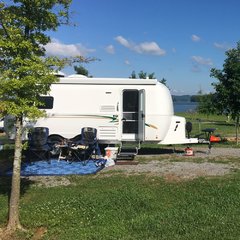
TPMS sensors and valve stem failures
Frank C replied to Frank C's topic in Mechanical & Technical Tips
For anyone with another brand of TPMS other than TireTraker, do the operating instructions have the same “recommendation” for metal valve stems? -

TPMS sensors and valve stem failures
Frank C replied to Frank C's topic in Mechanical & Technical Tips
Yeah, that’s the recommended solution posted on the other forums, or going with the internal sensors inside the tire. Either way, a significant bit of cost and downtime to upgrade all 4 wheels. Very mixed feelings at the moment about continuing to use the sensors with the rubber valve stems and risking catastrophic rapid leak(s) if one or more of the valve stems fail, or removing the sensors and going without the TPMS system for now and risking an unmonitored tire leak. TireTraker manual does say metal stems are “recommended” but not required. -
I have the TireTraker TPMS with the external sensors that thread onto the valve stem in place of the normal valve caps. While doing my spring cleaning on the Ollie, I noticed that all 4 aluminum rims have a wear mark on the rim directly adjacent to the valve stem (see picture). In researching this a bit, I found some comments on other forums about the weight of the external TPMS sensor causing the valve stem to deflect when the tire is rotating at highway speeds, and in some cases even causing the valve stem to fail. Anyone else observed this? Has anyone ever experienced a rubber valve stem failure while using the external sensors?
-
We are putting in a TPMS, TST 507 on our Ollie. Did anyone replace the Ollie rubber tire valve stems with brass valve stems for this system? One vendor says it is best to use brass valve stems.



